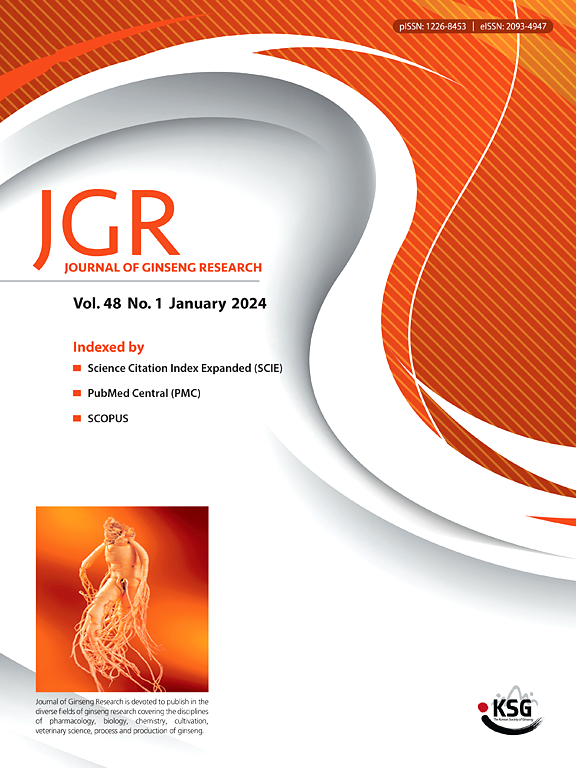Non-saponin from Panax ginseng maintains blood-brain barrier integrity by inhibiting NF-κB and p38 MAP kinase signaling pathways to prevent the progression of experimental autoimmune encephalomyelitis
IF 6.8
2区 医学
Q1 CHEMISTRY, MEDICINAL
引用次数: 0
Abstract
Background
The non-saponin (NS) fraction is an important active component of Panax ginseng, with multifunctional pharmacological activities including neuroprotective, immune regulatory, anti-inflammatory, and antioxidant effects. However, the effects of NSs on multiple sclerosis (MS), a chronic and autoimmune demyelinating disorder, have not yet been demonstrated.
Purpose
and Methods: The goal of the present study was to demonstrate the pharmacological actions of NSs on movement dysfunctions and the related mechanisms of action using an experimental autoimmune encephalomyelitis (EAE) mouse model of MS.
Results
NSs (p.o.) alleviated movement dysfunctions in EAE mice related to reduced demyelination in the lumbar spinal cord (LSC). NSs attenuated the recruitment of microglia (CD11b+/CD45low) and macrophages (CD11b+/CD45high) in LSCs from EAE model mice, consistent with the decreased mRNA expression levels of the main proinflammatory mediators (IL-1β, COX-2, MCP-1, MIP-1α, and RANTES). NSs blocked the migration of Th17 cells (CD4+/IL17A+) and mRNA expression levels of IL-17A (product of Th17 cells) in LSCs from EAE mice. NSs suppressed alterations in blood-brain barrier (BBB) components, such as astrocytes and cell adhesion molecules, associated with inhibiting NF-κB and p38 MAPK pathways in LSCs of EAE mice and lipopolysaccharide-induced bEND.3 cells.
Conclusions
NSs could attenuate movement dysfunctions and related pathological/inflammatory changes by reducing BBB permeability through NF-κB and p38 MAPK pathway inhibition in LSCs of EAE model mice. These are the first results suggesting that NSs can be potential therapeutic agents for MS by reducing BBB permeability.

人参非皂苷通过抑制NF-κB和p38 MAP激酶信号通路维持血脑屏障完整性,防止实验性自身免疫性脑脊髓炎的进展。
背景:非皂苷(non-saponin, NS)部分是人参的重要活性成分,具有神经保护、免疫调节、抗炎、抗氧化等多种药理活性。然而,NSs对多发性硬化症(MS)(一种慢性自身免疫性脱髓鞘疾病)的影响尚未得到证实。目的和方法:本研究的目的是通过实验性自身免疫性脑脊髓炎(EAE)小鼠模型来证明NSs对运动功能障碍的药理作用及其相关的作用机制。结果:NSs (p.o o)减轻了与腰椎脱髓鞘(LSC)减少有关的EAE小鼠的运动功能障碍。NSs降低了EAE模型小鼠LSCs中小胶质细胞(CD11b+/CD45low)和巨噬细胞(CD11b+/CD45high)的募集,与主要促炎介质(IL-1β、COX-2、MCP-1、MIP-1α和RANTES) mRNA表达水平降低一致。NSs阻断了EAE小鼠LSCs中Th17细胞(CD4+/IL17A+)的迁移和Th17细胞产物IL-17A的mRNA表达水平。NSs抑制了血脑屏障(BBB)成分的改变,如星形胶质细胞和细胞粘附分子,这些成分与EAE小鼠LSCs中NF-κB和p38 MAPK通路的抑制以及脂多糖诱导的bEND有关。3细胞。结论:NSs可通过抑制EAE模型小鼠LSCs中NF-κB和p38 MAPK通路,降低血脑屏障通透性,减轻运动功能障碍及相关病理/炎症变化。这些结果首次表明NSs可以通过降低血脑屏障的通透性而成为MS的潜在治疗剂。
本文章由计算机程序翻译,如有差异,请以英文原文为准。
求助全文
约1分钟内获得全文
求助全文
来源期刊

Journal of Ginseng Research
CHEMISTRY, MEDICINAL-INTEGRATIVE & COMPLEMENTARY MEDICINE
CiteScore
11.40
自引率
9.50%
发文量
111
审稿时长
6-12 weeks
期刊介绍:
Journal of Ginseng Research (JGR) is an official, open access journal of the Korean Society of Ginseng and is the only international journal publishing scholarly reports on ginseng research in the world. The journal is a bimonthly peer-reviewed publication featuring high-quality studies related to basic, pre-clinical, and clinical researches on ginseng to reflect recent progresses in ginseng research.
JGR publishes papers, either experimental or theoretical, that advance our understanding of ginseng science, including plant sciences, biology, chemistry, pharmacology, toxicology, pharmacokinetics, veterinary medicine, biochemistry, manufacture, and clinical study of ginseng since 1976. It also includes the new paradigm of integrative research, covering alternative medicinal approaches. Article types considered for publication include review articles, original research articles, and brief reports.
JGR helps researchers to understand mechanisms for traditional efficacy of ginseng and to put their clinical evidence together. It provides balanced information on basic science and clinical applications to researchers, manufacturers, practitioners, teachers, scholars, and medical doctors.
 求助内容:
求助内容: 应助结果提醒方式:
应助结果提醒方式:


